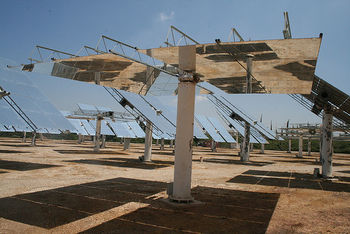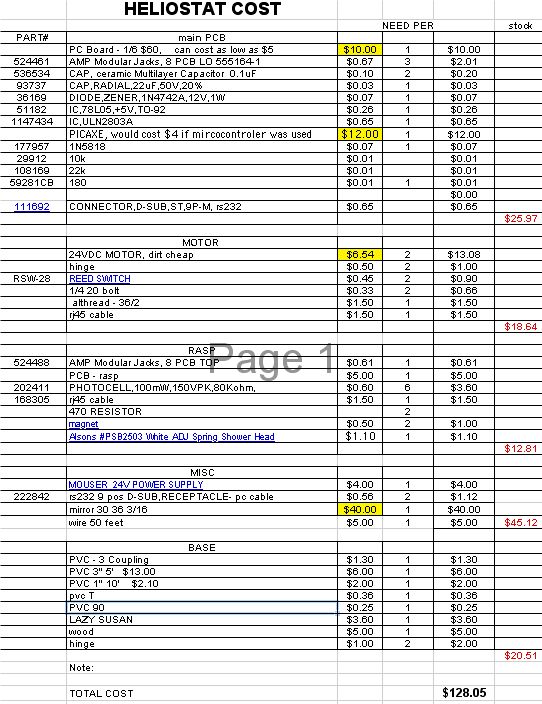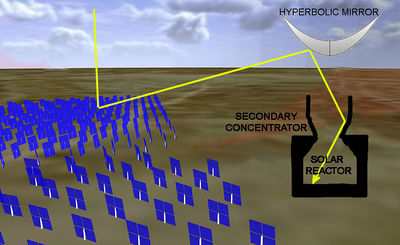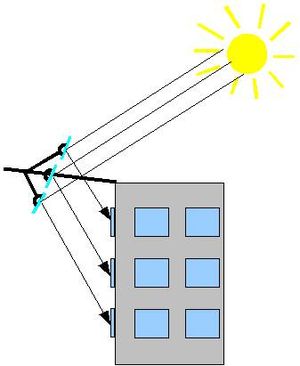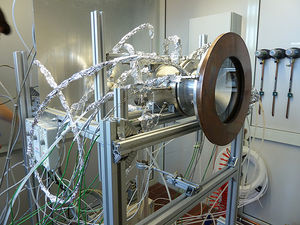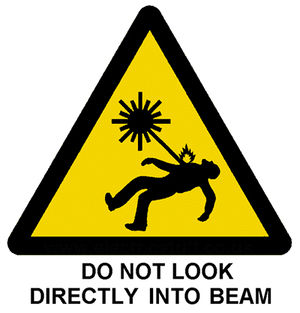Heliostat
Main > Energy > Solar Power
Basics
A heliostat is a mirror that tracks the sun and continuously reflects sunlight onto a fixed target. Heliostats are often controlled by electric motors which constantly move the mirror to compensate for the movement of the sun during the day and year. These movements may be calculated by a computer. Alternatively, a photosensor may be used to find the current position of the sun. Large solar thermal power plants sometimes consist of an array of heliostats that focus sunlight onto a central tower.
Various Corrospondences with SME's
Heliostats by Leo Gerst at Heliostat.us
Leo Gerst (link: Heliostat.us) has built heliostat prototypes that cost $130 per square meter total for a 2-axis tracking heliostat - using off-shelf parts. This is a breakthrough price achievement, and indicates potential economic feasibility of concentrator solar thermal power using heliostats on a small scale. For example, 30 such mirrors, at $4k - at 30 kW of energy focused on a square meter - could realistically power a heat engine. The detailed price list is:
Download the Excel spreadsheet for some sourcing links here.
Conversation of Leo Gerst with Marcin
- See heliostat prototypes from Leo (leogerst at hotmail dot com): http://www.heliostat.us/howitworks.htm
- Within 150 feet, 2.5 feet up and 6 foot wide.
- Home Depot mirror - 36x32" mirror - ended up being 5' wide for an image 115 feet - left to right was 4 feet, 1 foot high image, $40 at Home Depot
- Flat mirror is less expensive
- Motors for 8 dollars, so $16 per mirror. PIC, $12 - bootloader on processor, $3 for PIC itself, but $12 with program
- $1.20 for all-thread
- $150 controller - but go with OS
- Proof of concept: gather energy effectively. Make a hotspot.
- 1 ton turbine - 1 ton of water per hour
- $100 per panel
- Probably discount at 1000 glass pieces
- Pole in front in picture is the detector
- Photo sensors are $1 each, key to the project
- Shower head screws into PVC
Conversation of Leo Gerst with Alex Hornstein
Forwarded message ----------
From: Alex Hornstein <alex#at#nublabs#dot#com> Date: Fri, Aug 8, 2008 at 4:23 PM Subject: Re: Heliostat Thesis To: Leo Gerst <leogerst#at#gmail#dot#com>
hey Leo,
My (undergrad and only) thesis was actually on designing and building a handheld oscilloscope. I've been working for the past three or four years on heliostats and solar stuff in general, but I don't have any academic papers for you.
I like what you've done, and it looks pretty advanced. Nobody's ever beat a cost of $250 for a square meter of built, installed and actuated heliostat, and it's exciting that your cost is so low. Looking at your youtube video of your mirrors moving, I really appreciate your sensing solution--that's very smart and effective. I think your biggest problem right now is of accuracy. Looking at the step size of your mirrors as they move, it looks like their accuracy is worse than .5 degrees, and the maximum theoretical concentration a field of heliostats is limited by your angular error (as well as the optics of your receiver). I'd work on improving that.
Work by Gabriel Miller at Cerebral Meltdown
Heliostats are generally used for solar energy. Although not as popular as solar panels, they can potentially give you access to considerable amounts of untapped heat energy for a much lower price, assuming, of course, you build it yourself.
Work by Brendan from heliostats.org
Brendan from Heliostats.org has very detailed information about his open source heliostat project on his blog-like website. His concept uses gears printed out with a Makerbot. The heliostat is controlled by an Arduino.
Parts list: $100 per square meter (from a blog post, Oct 17th 2010)
- $1: Cinder block - Not what I used, but close enough.
- $1: Concrete - I used about 1/4 of a 50 lb bag to make one stat
- $3: 24” length 1/2”-13 threaded rod - Ballpark
- $1: 1/2”-13 nuts (3), washers (4) - Cost is a guess
- $9: 24” length 1 1/2" perforated angle iron and 12” length 1 1/2" angle iron - About $3/foot
- $10: Motors (2) - $5 each in quantities >50.
- $2: 1/4”-20 nuts, bolts and washers (say 12 each) - Guess
- $10: Plastic parts - Guess. This would be in volume
- $2: 12” 14”-20 threaded rod (2) - Roughly
- $6: In-line ball joints (2)
- $3: Phenolitic balls with 14"-20 threaded inserts (2) - I think I got these for 50 cents each, but using this for now
- $35: Mirror, 1 square meter, Ikea - Controversial. I'm sure true 'solar mirrors' have coatings for strength and UV resistance, etc, so this may give too cheap a perspective. But, these are also retail. ESolar is working with Google to figure out how to make cheaper solar mirrors. Here's a general link on the topic.
- $4: Wire - Guess -- .20/foot x 20 feet average per stat
- $5: Arduino - Maybe it's cheating, but I'm assuming one arduino runs at least 6 stats
- $3: Motor control electronics - Again, maybe cheating, but in any mature situation, these would be custom made for cheap.
In general, these are retail prices but without taxes or shipping. There are no costs for installation and profit. It's not meant to be perfect. In earlier calculations I've gotten into the $80 per square meter range and I still think that's possible.
My vision is something like an in-lawn sprinkler system. Central control is in the garage, 10-20 mirrors would be a typical residential installation. A home owner could do it themselves, or hire someone local who could install it all in a day or two and make $500 or so. 10-20 square meters of mirror isn't enough to power your house but if the ROI was 5%-10% it would attract some interest. A mid-tier application might be 100 heliostats generating about 10kW at peak, making the owner about $2K/year for a capital investment of $15K-$20K, so 10%+ return. A larger application would be an open source 'power tower' type configuration with thermal storage and power generation from steam turbines.
Note: For the figures above, the value of generated power assumes available solar energy of 1000 watts per square meter, with the conversion to electricity operating at 10% efficiency (100 watts per square meter). It assumes 5 hours a day of sun, 300 days a year, so this really only works for the US Southwest and similar climates. Power is considered to be worth .12/kW-hour -- whether used or sold back to the utility.
Work by Lucifer Ursum
Here is a heliostat which was sent in by Mark. He says that he has had it up and running for about a year now without having to make any recalibrations. It looks pretty cool. He has several more projects on his site besides just this one, so don't forget to check them out too. More information at Heliostaat.nl (in Dutch).
Dan Rojas and Josh Jordan at GreenPowerScience
Work by Rob at IwillTry.org
Array of 7 mirrors, each 1′x4′ in size mounted to a 4′x8′ plywood backing reinforced by a 2×3 frame to prevent warping. The frame is supported by a welded steel gimbal mount allowing rotation about both horizontal and vertical axes. Each axis is equipped with a stepper motor and leadscrew to adjust the position. Link here
Arduino-Based Heliostat Controller
From Daan van Geijlswijk, daan #at# zininzelfdoen.nl, who is working on an open source heliostat system: http://zininzelfdoen.ning.com/ . One particular focus of this effort is the development of lighting systems for buildings ("sun mirror")
Heliostat array
Multiple heliostats can be set up as large arrays, all focusing on one target. They may be arranged in an optical configuration such as a "beam-down" Cassegrain reflector (see right), which makes the energy very convenient to work with at ground level. Such arrays could be built in the agricultural setting, providing energy for a variety of uses on the farm itself and its surroundings (see next section, "applications"). The land could still be used for pasture, with decent biomass yield. A reasonably-sized array would collect thermal energy of 200-300 kW at peak, which might well be enough to make the farm completely energy independent. Note that the array can be focused on various different targets at different times. For some applications requiring high energy density (e.g. steam engine, thermochemistry, metallurgy etc.), the heliostats would focus on the hyperbolic mirror, while for other applications, a nearby greenhouse or large solar food dryer might be the target. The array could also be split up into different groups, reflecting onto separate targets for some time, then realigning again. The farmer would decide ahead of time how best to utilize the expected sunlight on any given day, and program the array accordingly. Having this additional energy available allows more of the added value (food, fuels) to be captured on the farm.
These ideas are featured in more detail at the Open Heliostat Array Project page.
Various applications and product ecology
- generally, there are broad uses for concentrating solar power (CSP).
- lighting and space heating for buildings (provides additional degrees of architectural freedom, e.g. house doesn't have to have large south facing windows, can have smaller windows if there are heliostats funneling in sunlight and heat; could improve underground housing and Earthships)
- improved solar cooking, canning and baking. Also solar food drying: more heat = faster drying - very important if you don't want your fruits and vegetables to rot in the dryer. Allows for much greater volumes to be processed. Build a "heat bank" (of CEBs, metal, concrete, water etc.) to dry food even on cloudy days. No heliostat, no heat bank !
- biomass drying, even solar torrefaction (examples of wet biomass: biogas slurry, manure, humanure, duckweed, wood etc.)
- solar pyrolysis system for biochar production where all of the heat comes from sunlight rather than from the pyrolysis products such as bio-oil and various organic chemicals. This way, none of the pyrolysis products would have to be burned up to keep the reaction going. This would increase the efficiency of biomass use. It is an unproven idea - no designs exist.
- enhanced lighting and heating of greenhouses (example: Walipini/earth sheltered greenhouse), either directly or by first heating hot water
- solar alarm clock (let's hope that the sun is shining when you have to wake up !)
- improved electricity yield of photovoltaic cells (more light=more power, although at some point the PV cells get too hot and efficiency goes down; this can be prevented by coupling with a solar water heating system which keeps the PV cells cool and puts out hot water at the same time)
- water heating for various applications; examples: aquaponics (see Tilapia aquaculture)
- solar thermal water treatment, disinfection, sewage treatment
- solar desalination (see Oceansource)
- steam (and superheated steam) for a wide variety of uses (sterilizing and cleaning things, soil sterilization, industrial process heat, etc.)
- to power an open source modern steam engine
- solar fuels: fuels can be solar-upgraded in various ways. The calorific value of a liquid (bio-)fuel can be increased by solar input. Fossil fuels can similarly be solar-upgraded via endothermic processes (e.g. solar reforming or cracking of natural gas, solar gasification of coal, whereby coal is not combusted but used as a reactant in a process fuelled by CSP.
- one example of a solar fuel is: methane to methanol, using concentrated sunlight. Source of methane is biogas or syngas. Methanol is a fuel that is liquid at room temperature (=does not require compression) and can be used in an internal combustion engine. It is increasingly popular in China to power vehicles.
- solar hydrogen production: either from splitting water (difficult and requires high temperatures, although catalysts are being developed to improve this), or by solar thermal cracking of methane.
- solar calcination for the production of lime and cement (proven concept: solar chemical reactor. Lime can be used for the stabilization of CEBs. The calcination process (in whatever way it is done) requires high temperatures of 900-1000°C or higher. Not a problem on a sunny day but you will need multiple heliostats or your focus point will be too tiny to get any serious amount of calcination done. Lime is also an essential ingredient for the production of acetylene. Solar thermochemical processing (for fuels) is also described here in detail.
- solar sintering of sand and clays to make construction materials such as tiles, bricks and pipes. This technology is being developed in the US (NASA, private companies) for the purpose of melting lunar regolith (ref and ref. A concentrated beam of light is focused onto the substrate, heating it up but not to melting temperature. The grains stick together, solidifying the material.
- extreme solar concentration for metallurgy (i.e. "solar furnace"). One would focus multiple heliostats onto one spot, then concentrate the light further with either a parabolic mirror (metal please, hold the polycarbonate !) or Fresnel lens, hopefully made of glass, not plastic). The disadvantage of a glass Fresnel lens is the huge expense (unless the glass can be CNC-milled). Its advantage is that work can occur behind the lens, offering far better worker protection. In contrast, the parabolic lens has its focus point in the path of incoming light - clearly not ideal when you want to work there, smelting away). We don't call it death ray metallurgy for nothing ! At any rate, the idea would be carbothermal reduction using solar energy, which requires a methane or hydrogen atmosphere and temperatures of 1050 - 1100°C (Allen et al., 1994). Please have a look at the videos shown on the metal refining page for what such a system might look like.
- combining solar concentrator with gas-fired flame to reach higher temperatures (i.e. gas = methane, biogas or syngas). Light is concentrated into flame; important for metallurgy and solar calcination (steel melts at 1400-1500°C, limestone is calcined at 900-1000°C)
- combining solar concentrator with induction furnace: scrap metal is pre-heated to (say) 600°C under a Fresnel lens, then quickly thrown into the induction furnace for complete melting. This saves precious electricity and fuel to generate electricity. A triple combo is also possible: solar concentrator + gas-fired flame for pre-heating, then the induction furnace. For many metals, solar and gas may be able to achieve most of the way to the melting point, and then induction does the rest (melting points: aluminum 660°C, copper 1084°C, iron 1350°C)
- Applications in the production of special materials. Many new materials have interesting properties but require high initial energy input (one example is the carbonization of chicken feathers). This can in part or completely be provided by CSP.
- Molding plastic parts using concentrated heat from multiple heliostats. The heliostat beam is targeted onto a rotational mold which is coated with solar absorptive paint. The technology was developed by LightManufacturing. Final part cost is reduced between 10% and 30% depending on local energy, labor, and material costs.
